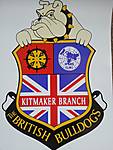Hi Paul,
The Mr Models kit is the Mk II or Mk III mortar. The Mk I was introduced in 1916 with about 30 being deployed in June that year. It had a 51 inch barrel length. The Mk II and Mk III had a 69 inch barrel and were deployed in 1917 with some MkIV being added towards wars end of the war. The were used by the British, Australians and Americans.
The bumpers you refer to are the carry handles for the base. If you look at the pics you will see the empty fixings both front and back for these, which were naturally removed when located in place. The model is a mixture of resin and white metal parts and these come with the handles and fixings as one.
As I said to be accurate in this time period this would need to be a Mk I. I made several errors in the original build all of which have been corrected although I still have a Mk III not a Mk I. I have three options, strip the barrel down and cut it down or get another and start afresh, or leave as is.
Hind sight is a great thing but at the time of the build I had little information to work on. I've got a small amount of data now plus when I was searching for pictures for Al B, I came across the US manual for the mortar which I down loaded last night, which I'll have a browse through.
Not a good picture but with the base corrected and carry handles in place.

I've dug the mortar in a bit more as it is clear form the pics that this seemed to be common practice. My bombs arrived this morning so I'll be able to create a nice pile of shells. some in crates and some being stacked in readiness for the attack. Whether this turns out to be a Mk I or III you have to wait and see as this project is very much an ongoing a WIP. I don't have a problem with the creates being put on top, space was at a premium and they would either have been chopped up for firewood or returned from whence they came later. They are artistic license at best, as I've never seen a created bomb but they work for me at least until I see some alternative.
If you Google 9.45 inch Heavy Trench Mortar you can probably find the US Manuel that might answer a lot of your questions and probably raise a few others.
Hi Al,
You'll have to await developments!
Hi Jerry,
Thanks - long way to go yet.
Cheers
Al

















































